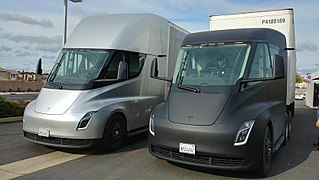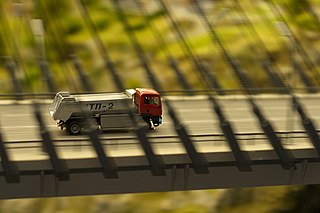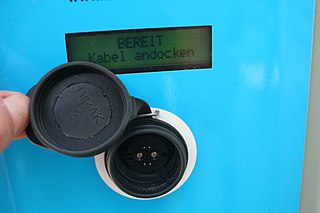Different methods of transport in South Africa include roads, railways, airports, water, and pipelines for petroleum oil. The majority of people in South Africa use informal minibus taxis as their main mode of transport. BRT has been implemented in some South African cities in an attempt to provide more formalised and safer public transport services. These systems have been widely criticised due to their large capital and operating costs. A "freeway" is different from most countries as certain things are forbidden which include certain motorcycles, no hand signals, and motor tricycles. South Africa has many major ports including Cape Town, Durban, and Port Elizabeth that allow ships and other boats to pass through, some carrying passengers and some carrying petroleum tankers.

A hybrid vehicle is one that uses two or more distinct types of power, such as submarines that use diesel when surfaced and batteries when submerged. Other means to store energy include pressurized fluid in hydraulic hybrids.

IVECO S.p.A., an acronym for Industrial Vehicles Corporation, is an Italian industrial vehicle manufacturing company based in Turin, Italy, and a wholly owned subsidiary of CNH Industrial Group. It designs and builds light, medium and heavy commercial vehicles, quarry/construction site vehicles, city and intercity busses and special vehicles for applications such as firefighting, off-road missions, the military and civil defence. The name Iveco first appeared in 1975 after a merger of Italian, French and German brands. Its production plants are in Europe, Brazil, Russia, Australia, Africa, Argentina and China, and it has approximately 5,000 points of sales and service in over 160 countries. The worldwide output of the company amounts to around 150,000 commercial vehicles with a turnover of about €10,000,000,000.

An electric vehicle (EV), also called electrics is a vehicle that uses one or more electric motors or traction motors for propulsion. An electric vehicle may be powered through a collector system by electricity from off-vehicle sources, or may be self-contained with a battery, solar panels, fuel cells or an electric generator to convert fuel to electricity. EVs include, but are not limited to, road and rail vehicles, surface and underwater vessels, electric aircraft and electric spacecraft.

A solar vehicle or solar electric vehicle is an electric vehicle powered completely or significantly by direct solar energy. Usually, photovoltaic (PV) cells contained in solar panels convert the sun's energy directly into electric energy. The term "solar vehicle" usually implies that solar energy is used to power all or part of a vehicle's propulsion. Solar power may be also used to provide power for communications or controls or other auxiliary functions.

An electric bus is a bus that is powered by electricity.

Inductive charging is a type of wireless power transfer. It uses electromagnetic induction to provide electricity to portable devices. The most common application is the Qi wireless charging standard for smartphones, smartwatches and tablets. Inductive charging is also used in vehicles, power tools, electric toothbrushes and medical devices. The portable equipment can be placed near a charging station or inductive pad without needing to be precisely aligned or make electrical contact with a dock or plug.

A battery electric bus is an electric bus that is driven by an electric motor and obtains energy from on-board batteries. Many trolleybuses use batteries as an auxiliary or emergency power source.

An electric vehicle charging station, also called EV charging station, electric recharging point, charging point, charge point, electronic charging station (ECS), and electric vehicle supply equipment (EVSE), is a machine that supplies electric energy for the recharging of plug-in electric vehicles—including electric cars, neighborhood electric vehicles and plug-in hybrids.

Smith Electric Vehicles is a manufacturer of electric trucks. The company, founded in 1920 in the north of England, moved its headquarters to Kansas City, Missouri in 2011. Smith suspended all operations in 2017.

A battery electric vehicle (BEV), pure electric vehicle, only-electric vehicle or all-electric vehicle is a type of electric vehicle (EV) that exclusively uses chemical energy stored in rechargeable battery packs, with no secondary source of propulsion. BEVs use electric motors and motor controllers instead of internal combustion engines (ICEs) for propulsion. They derive all power from battery packs and thus have no internal combustion engine, fuel cell, or fuel tank. BEVs include – but are not limited to – motorcycles, bicycles, scooters, skateboards, railcars, watercraft, forklifts, buses, trucks, and cars.
ECOtality, Inc., headquartered in San Francisco, California, was an electric transportation and storage technologies company. ECOtality was the parent company of ECOtality North America, Innergy Power Corporation, Fuel Cell Store and ECOtality Australia Pty Ltd.
Power Vehicle Innovation or PVI is a French truck and bus manufacturer, based in Gretz-Armainvilliers near Paris, France, specialized in electric powertrains.

The Oréos 4X is a 49-places electric midibus of the Gepebus' line of products, from Power Vehicle Innovation. Made for the operating of some urban regular lines, or also a private usage, the Oreos 4X is among the first entirely electric autobuses produced in France. This clean vehicle belongs to a new generation, more efficient for the power than the older models, and therefore helps to reduce the environmental impact of the transport in the cities.

Gépébus is a trademarked private sector brand name for electric autobuses made by Power Vehicle Innovation for use in mass public transportation.
The Lion Electric Company is a Canadian-based bus manufacturer. Currently the smallest manufacturer in its segment, Lion primarily produces yellow school buses, specializing in battery-electric powertrains.

EnergyBus connectors are used for charging electric bicycles and pedelecs within Europe. The connector is circular in shape and specified for charging light electric vehicles at up to 1.5 kilowatts. Electric power is provided at 12–48 volts direct current (DC) so that any battery charger can charge any rechargeable battery.

A solar bus or solar-charged bus is a bus which is powered exclusively or mainly by solar energy. A solar-powered bus service is referred to as a solar bus service. The use of the term "solar bus" normally implies that solar energy is used not only for powering electric equipment on the bus, but also for the propulsion of the vehicle.














